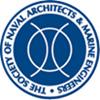吊钩、拦截器和喷水器对LCS阻力/功率、下沉和配平的影响
IF 1
4区 工程技术
Q3 ENGINEERING, CIVIL
引用次数: 0
摘要
对高速濒海战斗舰(LCS)水面作战舰艇进行了模型和全尺寸计算流体动力学仿真,包括钩、拦截器和喷水推进的影响。机体力、推力、下沉和内饰的预测使用速度控制器来实现自我推进。水射流性能采用两种方法:1)基于船体和水射流管道、泵壳和喷嘴上湿区应力的综合力评估(积分法)和2)ITTC(2005)水射流测试程序(控制容积法)。使用弗劳德(Fr)比例模型和全尺寸试验数据,包括截流器和水射流(WJ)对阻力/功率、下沉和内倾的影响,模型(阻力、下沉和内倾)和满尺寸(功率和内倾)的比较误差都令人满意。对于不含wj的模型-尺度模型,分别观察了无钩、有钩和带钩试验时射流入口附近的负底动水压力。在没有吊钩的模拟中,在喷水口附近的负底部垂直力支持了Savitsky(2014)关于半排水量单体船型不表现出水动力升力的断言,并反驳了Giles(1992)相反的断言。钩和截流器对水射流入口附近的压力分布影响不大。对于全比例尺模型,wj诱导了模拟和内插(在条件之间)和Fr比例模型尺度实验的弓形修剪。在模拟中,水射流入口附近的负底压和垂直力反驳了Giles(1992)关于wj提供额外水动力升力的断言。Bulten(2005)在一艘高速机动游艇上对LCS的垂直力%推力和入口速度比进行了比较,结果进一步支持了这一点。Bulten(2005)表明,进口速度比≥1.25时垂直力为正。然而,LCS在进口速度≤1.2的情况下工作;因此,与Bulten(2005)一致,垂直力为负。拦截弹和wj之间的非线性效应很小,因此线性组合可以提供合理的近似。本文章由计算机程序翻译,如有差异,请以英文原文为准。
Effects of Hook, Interceptor, and Water Jets on LCS Resistance/ Power, Sinkage, and Trim
Verification and validation of computational fluid dynamic simulations are performed at model and full scales for the high-speed littoral combat ship (LCS) surface combatant, including the effects of hook, interceptors, and water-jet propulsion. Predictions of the body force thrust, sinkage, and trim use a speed controller for attaining self-propulsion. Two methods for water-jet performance are used: 1) evaluation of forces based on integration of the stress over the wetted area of the hull and water-jet duct, pump casing, and nozzle (integral method) and 2) ITTC (2005) water-jet test procedure (control volume method). The comparison errors at model (resistance, sinkage, and trim) and full (power and trim) scales are satisfactory using both Froude (Fr) scaled model- and full-scale trial data, including the effects of the interceptors and water jets (WJ) on resistance/power, sinkage, and trim. For the model-scale model without WJs, the negative bottom hydrodynamic pressure near the water-jet inlets are observed without and with the hook simulations, and experiments with the hook. The negative bottom vertical force near the water-jet inlets for the simulations without the hook supports Savitsky’s (2014) assertion that semi-displacement monohulls do not exhibit hydrodynamic lift and disproves Giles’ (1992) assertion to the contrary. The hook and interceptors do not affect the pressure distribution significantly near the water-jet inlets. For the full scale model, the WJs induce bow up trim for the simulations and interpolated (between conditions)- and Fr scaled model-scale experiments. The negative bottom pressure and vertical force near the water-jet inlet for the simulations disprove Giles’ (1992) assertion that the WJs provide additional hydrodynamic lift. This is further supported by the comparisons of the vertical force % thrust vs. inlet velocity ratio for the LCS, with results shown in Bulten (2005) for a high-speed motor yacht. Bulten (2005) shows positive vertical force for inlet velocity ratios ≥ 1.25. However, LCS operates in the regime of an inlet velocity ≤ 1.2; thus, consistent with Bulten (2005), the vertical force is negative. The nonlinear effects between the interceptors and WJs are small such that a linear combination can provide a reasonable approximation.
求助全文
通过发布文献求助,成功后即可免费获取论文全文。
去求助
来源期刊

Journal of Ship Research
工程技术-工程:海洋
CiteScore
2.80
自引率
0.00%
发文量
12
审稿时长
6 months
期刊介绍:
Original and Timely technical papers addressing problems of shipyard techniques and production of merchant and naval ships appear in this quarterly publication. Since its inception, the Journal of Ship Production and Design (formerly the Journal of Ship Production) has been a forum for peer-reviewed, professionally edited papers from academic and industry sources. As such, it has influenced the worldwide development of ship production engineering as a fully qualified professional discipline. The expanded scope seeks papers in additional areas, specifically ship design, including design for production, plus other marine technology topics, such as ship operations, shipping economic, and safety. Each issue contains a well-rounded selection of technical papers relevant to marine professionals.
 求助内容:
求助内容: 应助结果提醒方式:
应助结果提醒方式:


